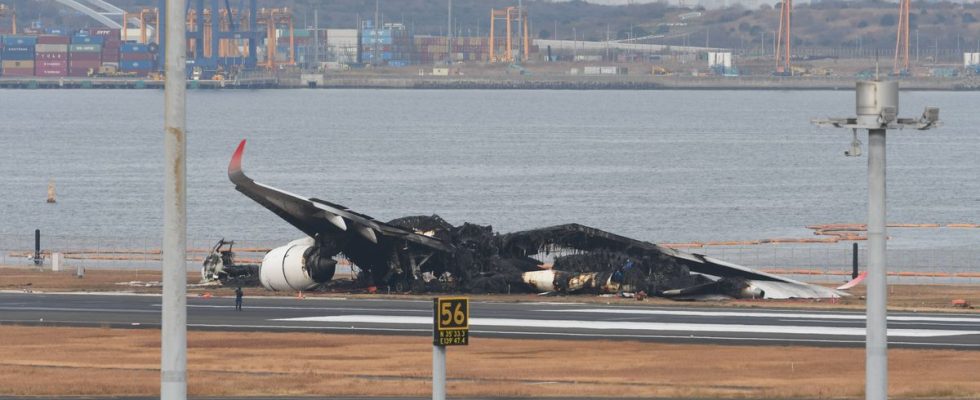The accident that occurred Tuesday at Tokyo-Haneda Airport, Japan, was spectacular and unfortunately fatal for five passengers. The Airbus pilots claimed not to have seen the much smaller aircraft with which they collided and to have only felt the “impact” upon landing.
“We couldn’t make eye contact [avec l’avion des garde-côtes]”, the pilots told us,” a JAL spokesperson told AFP, regarding the accident which left five passengers dead among the passengers of the Bombardier Dash 8 hit by the Japanese company’s Airbus. “They say it was just as the wheels touched the ground or were about to hit the ground that they felt an impact,” he added. “One of the three drivers told us said he saw an object just before impact.”
The device went up in smoke
Tuesday at 5:47 p.m. (9:47 a.m. French time), while night had fallen over Tokyo, the JAL516 coming from Sapporo, in the north of the archipelago, collided upon landing with a smaller aircraft, which was preparing to take off towards the Noto peninsula (center) where a terrible earthquake occurred on Monday. The impact caused an impressive explosion and the Airbus A350-900 immediately caught fire, coming to rest a few hundred meters further to the side of the runway.
All of the plane’s 379 passengers and crew members were evacuated before the Airbus went up in smoke on the side of the runway. The JAL spokesperson also clarified that the pilots were initially unaware that their aircraft was on fire. “Unlike vehicles, they do not have rear-view mirrors. When the fire started [à l’arrière de l’appareil], they could not see him from the cockpit. It was the cabin crew who warned them, said the JAL communicator.
The causes of the collision still unexplained
According to the NHK television channel, they only became aware of the fire when the cabin manager asked them for authorization to open the emergency exits, while the cabin was beginning to be invaded by smoke and a intense heat causing the start of panic. Due to the fire, only two slides could be activated at the front of the aircraft, according to NHK.
The causes of the collision are still unexplained, but “human error” probably contributed, say two aviation experts, Doug Drury, of the University of Central Queensland, and Terence Fan, of the Singapore Management University. Tuesday evening, during a press briefing, a Japan Airlines manager affirmed that permission to land “had been given” to the Airbus, a version supported by radio exchanges from the control tower, that the AFP consulted on the LiveATC.net site.
According to the continuation of these radio exchanges communicated Wednesday by the Japanese Ministry of Transport, the control tower asked a few seconds later for the coast guard plane to move to a stopping point, away from the track. But according to a coast guard official mentioned by NHK, the surviving pilot of the Bombardier claimed just after the accident to have obtained permission to take off.

